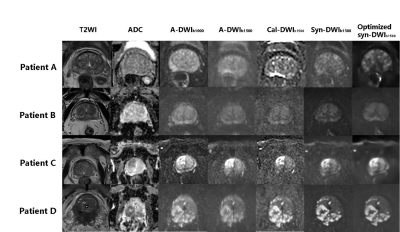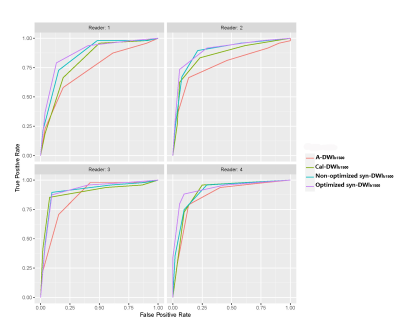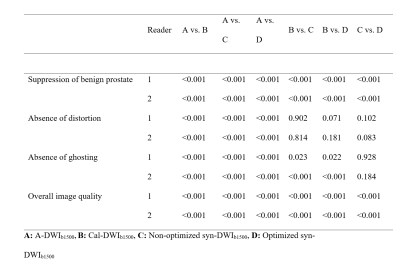1336
Deep learning for synthesizing high-b-value DWI of the prostate: A tentative study based on generative adversarial networks1Department of Diagnostic and Interventional Radiology, Shanghai Jiao Tong University Affiliated Sixt, 上海, China, 2Department of Diagnostic and Interventional Radiology, Shanghai Jiao Tong University Affiliated Sixt, shanghai, China, 3MR Application Development, Siemens Shenzhen magnetic Resonance Ltd, shanghai, China, 4MR Application Predevelopment, Siemens Healthcare, Erlangen, Gernmany, Erlangen, Germany
Synopsis
A deep learning framework based on a generative adversarial network (GAN) to synthesize high-b-value DWI (syn-DWIb1500) with high quality using the acquired standard b-value DWI (a-DWIb800-1000) was developed. Reader ratings for image quality and PCa detection were performed on the a-DWI b1500, syn-DWIb1500, and optimized syn-DWIb1500 sets. Wilcoxon signed-rank tests and MRMC-ROC were used to compare the readers’ scores and diagnostic capabilities of each DWI set, respectively. Optimized syn-DWIb1500 resulted in significantly better image quality (all P≤0.001) and a higher mean AUC than a-DWIb1500 and cal-DWIb1500 (all P≤0.042).
Purpose
This study aimed to develop and evaluate a deep learning framework based on a generative adversarial network (GAN) to synthesize high-b-value DWI (syn-DWIb1500) with zoomed-DWI (z-DWIb1500)-like quality using the acquired full-FOV DWI (a-DWIb800-1000).Methods
This retrospective, multi-center study included 395 patients who underwent prostate MRI. This cohort was divided into training dataset (96 patients) and testing dataset (299 patients). All patients in the training dataset underwent both full-FOV DWI (f-DWI) and zoomed-FOV DWI (z-DWI) with b-values of 50, 1000, and 1500 s/mm2 on a 3T MRI scanner (MAGNETOM Skyra, Siemens Healthcare, Erlangen, Germany). The testing dataset including only f-DWI were acquired on five different 3T scanners. To synthesize high-quality DWIb1500 from a-DWIb800-1000 with the ground truth z-DWIb1500, a framework based on GAN was developed using an internal dataset. A model based on the framework (M0) was trained and compared with a conventional model based on cycle-GAN (Mcyc). M0 was further optimized using denoising and edge enhancement techniques (optimized M0). The syn-DWIb1500 based on M0 and optimized M0 were synthesized using a-DWIb800-1000 in the external testing dataset. For comparison, the traditional calculated DWIb1500 (cal-DWIb1500) was also obtained. Reader ratings for image quality and PCa detection were performed on a-DWI, cal-DWIb1500, syn-DWIb1500, and optimized syn-DWIb1500 sets. Wilcoxon signed-rank tests were used to compare the readers’ scores. Multiple-reader, multiple-case receiver operating characteristic was used to compare the diagnostic capabilities of each DWI set.Results
Regarding quantitative evaluation, M0 had lower MSD than Mcyc (0.002 vs. 0.004; P<0.001) but higher mean scores of SSIM, FSIM, and PSNR:M0 (0.819, 0.901, 27.40, respectively; Mcyc:0.793, 0.873, 24.67, respectively; all P<0.001) (Fig.1). This indicates that syn-DWIb1500 generated by M0 is more similar to z-DWIb1500 than to syn-DWIb1500 generated by Mcyc。 As shown in Fig. 2, among the four DWI sets (a-DWIb1500, cal-DWIb1500, non-optimized syn-DWIb1500, and optimized syn-DWIb1500), optimized syn-DWIb1500 has the clearest contour of the prostate and lesions, the best suppression of normal prostate tissue, and the least amount of noise and artifacts in visual perception. Table 1 and Table 2 show the results of the image quality assessments of the four DW images for the two reviewers. Cal-DWIb1500, non-optimized syn-DWIb1500, and optimized syn-DWIb1500 sets had significantly better image qualities than a-DWIb1500 sets in terms of suppression of benign prostate tissue, anatomic distortion, artifacts, and overall image quality for both readers (all P<0.001). Non-optimized syn-DWIb1500 and optimized syn-DWIb1500 sets had significantly better overall image quality (P<0.001) and suppression of benign prostate (P<0.001) as well as fewer ghosts than cal-DWIb1500 sets for both reviewers (P<0.023). There was no significant difference in the absence of distortion among cal-DWIb1500, non-optimized syn-DWIb1500, and optimized syn-DWIb1500 sets for either reader (P≥0.071). Compared with non-optimized syn-DWIb1500 sets, optimized syn-DWIb1500 sets had significantly better suppression of benign prostate and overall image quality (P<0.001), but no other comparison between the two DWI sets shows significant difference for either reader (P≥0.083). The mean AUCs of the a-DWIb1500, cal-DWIb1500, non-optimized syn-DWIb1500, and optimized syn-DWIb1500 sets across readers were 0.792, 0.859, 0.882, and 0.897, respectively (Fig.3). The differences in mean AUCs between a-DWIb1500 and cal-DWIb1500, non-optimized syn-DWIb1500, and optimized syn-DWIb1500 were statistically significant (P ≤ 0.006). The difference in mean AUCs between cal-DWIb1500 and optimized syn-DWIb1500 sets was also statistically significant (P =0.042). The differences in mean AUCs between the remaining DWI sets were not statistically significant (a-DWIb1500 vs. non-optimized syn-DWIb1500, P=0.119; non-optimized syn-DWIb1500 vs. optimized syn-DWIb1500, P = 0.496).Discussion
The main contribution of our study is that we proposed a deep learning model based on a GAN to generate high-b-value DWI sets, which proved to have better image quality and tumor detection capability than the acquired DWI and the calculated DWI sets. In our study, z-DWIb1500 was chosen as the reference to train the synthesis discriminant network because it has been widely proven that zoomed-DWI results in better image quality, including fewer artifacts, blur, distortion, and higher spatial resolution than full-FOV DWI. The high similarity between syn-DWIb1500 and z-DWIb1500 in structure and texture features is the principal reason why syn-DWIb1500 results in better image quality than a-DWIb1500 and cal-DWIb1500 in multicenter datasets. For tumor detection, the mean AUCs of optimized syn-DWIb1500 sets were higher than those of a-DWIb1500 and cal-DWIb1500 sets. This suggests that the optimized syn-DWIb1500 sets can improve the tumor detection capability of radiologists. Unlike the acquired DWI, our framework can effectively save scanning time (1) since higher-b-value DWI acquisition requires more averages to ensure a sufficient signal-to-noise ratio. Although the cal-DWI technique can also generate high-b-value DWI sets using lower b-value images, it requires DWI sets acquired with at least two lower b-values (2), whereas for our method, only a DWI set acquired with only one lower b-value is needed. Moreover, image quality of cal-DWI with high b-values depends on the image quality of lower-b-value images (3), whereas using our model, acquired full-FOV DWI can be used to generate high-b-value DWI sets, in which the image quality is better than that of acquired-DWI sets.Conclusion
A deep learning framework based on GAN is a promising method to synthesize realistic high-b-value DWI sets with good image quality and accuracy in PCa detection.Acknowledgements
No acknowledgement found.References
1. Yildirim IO, Saglik S, Celik H. Conventional and ZOOMit DWI for Evaluation of Testis in Patients With Ipsilateral Varicocele. AJR Am J Roentgenol. 2017;208(5):1045-50.
2. Jendoubi S, Wagner M, Montagne S, et al. MRI for prostate cancer: can computed high b-value DWI replace native acquisitions? Eur Radiol. 2019;29(10):5197-204.
3. Ueno Y, Takahashi S, Ohno Y, et al. Computed diffusion-weighted MRI for prostate cancer detection: the influence of the combinations of b-values. Br J Radiol. 2015;88(1048):20140738.
Figures




Table 1. Comparison of subjective image quality between different diffusion-weighted imaging sets.
Note: Image quality features were rated by each reader using a five-point Likert scale (with 1 for poor, 2 for below average, 3 for average, 4 for above average, and 5 for excellent) A-DWIb1500: Acquired DWI with b-value =1500 s/mm2; Cal-DWIb1500: calculated DWI with b-value =1500 s/mm2; Syn-DWIb1500: synthesized DWI with b-value =1500 s/mm2 based on M0, Optimized syn-DWIb1500: synthesized DWI with b-value =1500 s/mm2 based on optimized M0.

Table 2. The comparison of DWI sets for image quality
A: A-DWIb1500, B: Cal-DWIb1500, C: Non-optimized syn-DWIb1500, D: Optimized syn-DWIb1500